3. Bonding and Nesting - Pigeons, Barbets, Weavers and Bulbuls
All birds are "Oviparous": they lay eggs. These eggs must be incubated. In other words, they must be kept warm by the parents in order for the chicks to develop inside them. Although some birds lay only one egg, most lay a "Clutch" of at least two eggs. All species have in common the "Cloaca", an orifice through which waste material is excreted and from which semen is secreted by the male and passed into the female. Mating, known as the "cloacal kiss" takes only a few seconds unlike the prolonged courtship displays that precede it.
The next two section look at examples of avian relationships from "Polygamous", birds that take more than one partner in the same season, to "Monogamous"birds who are faithful partners for life. We shall follow species and families through the nest building, incubation and chick rearing stages. There is a truly remarkable variety in nest construction and the eggs laid within them, the incubation time scale and the chicks that eventually emerge and the extent of parental care.
I use Latin family names in this section. Please refer to the Speciation section for an explanation of bird taxonomy.
Columbidae - the Pigeons and Doves
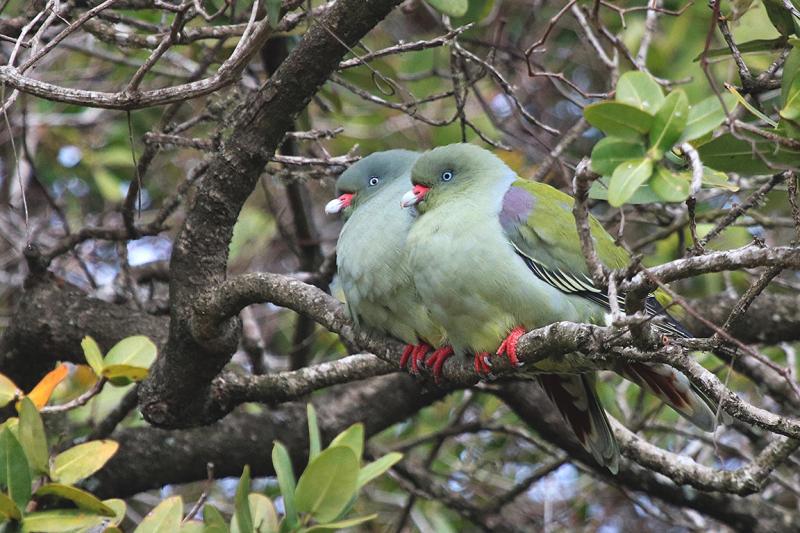
African Green Pigeon
This old married couple were photographed on Incaha Island, Mozambique.
Pigeons and doves are generally monogamous and form partnerships for life. Some columbids are solitary while others nest in colonies. The males collect the nesting material while the female constructs the nest. The nest is made of twigs which may be in a tree or a rock face, on top of an abandoned nest or in a building. Some nests are a crude platform of twigs and others are more substantial with a shallow cup. The nests take only 3 or 4 days to construct and are defended from intruders.
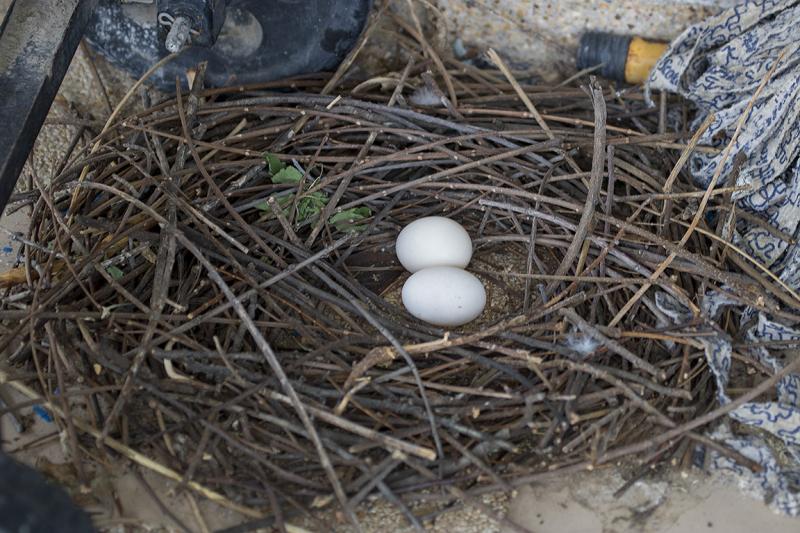
Feral Pigeon Nest
I came back fo find this completed nest on my balcony in Bangkok after a long weekend away. I have aleady photographed the culprits engaged in a courting display a few days earlier (see previous section). These feral pigeons obviously thought they had found an undisturbed location for their nest site. Columbids usually lay only one or two eggs because their fruit and seed diet often lacks protein and they can only raise one chick. The male brings the twigs and the female constructs the nest.
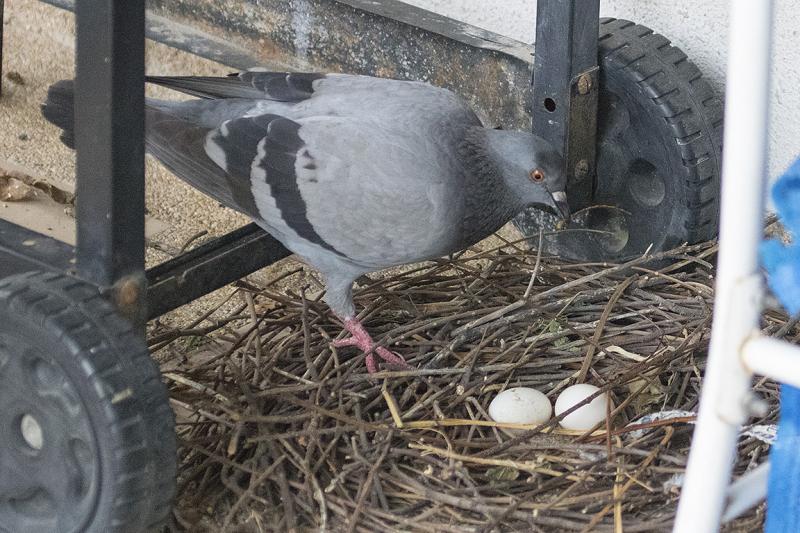
Feral Pigeon - Female
Even during incubation, the male brought twigs and the female continued to enlarge the nest.
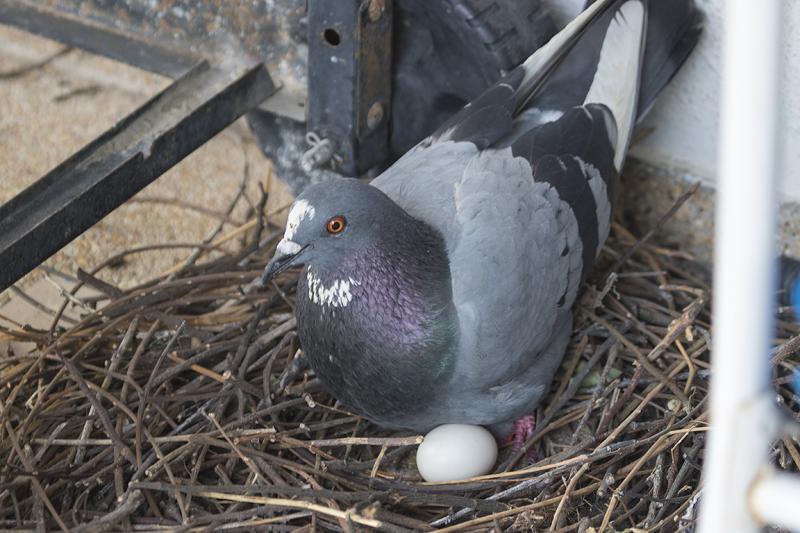
Feral Pigeon - Male
Both males and females share incubation although females spend more time on the nest. Here the male settles down to incubate the eggs.
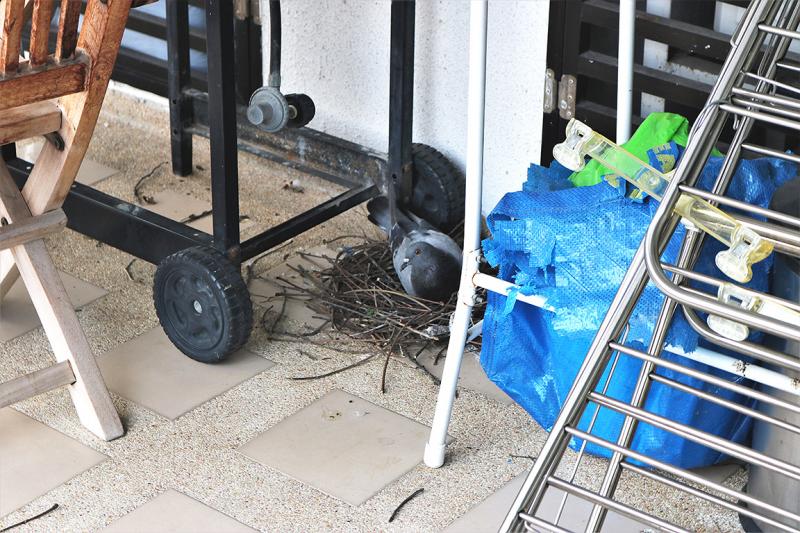
Feral Pigeon - Female
This final picture shows the unfortunate location chosen by our pigeons, sandwiched between the barbecue and a clothes rack. The ending was not happy as they deserted the nest before the eggs hatched, probably because there was too much disturbance on a much used balcony. Had the chicks hatched, they would have been "Altricial", born naked, blind and helpless and fed by both parents for around 30 days.
Feral pigeons are usually escaped domestic pigeons which in turn are the descendants of rock pigeons. The female of our couple retains the markings of the rock dove whereas the male seems to have inherited some additional white plumage from one or more of his ancestors. Their rock pigeon ancestry leaves them partial to nesting locations on ledges, niches in buildings, roof tops and of course balconies.If food supply allows, columbids will rear up to five broods a year to compensate for the low brood size and high predation rates.
Feral pigeons are considered a pest as they leave excrement and carry disease. One good, albeit brief, outcome of our nesting pigeons was that they guarded their territory aggessively and kept other pigeons away greatly reducing the amount of mess on our balcony.
Megalaimidae - The Asian Barbets
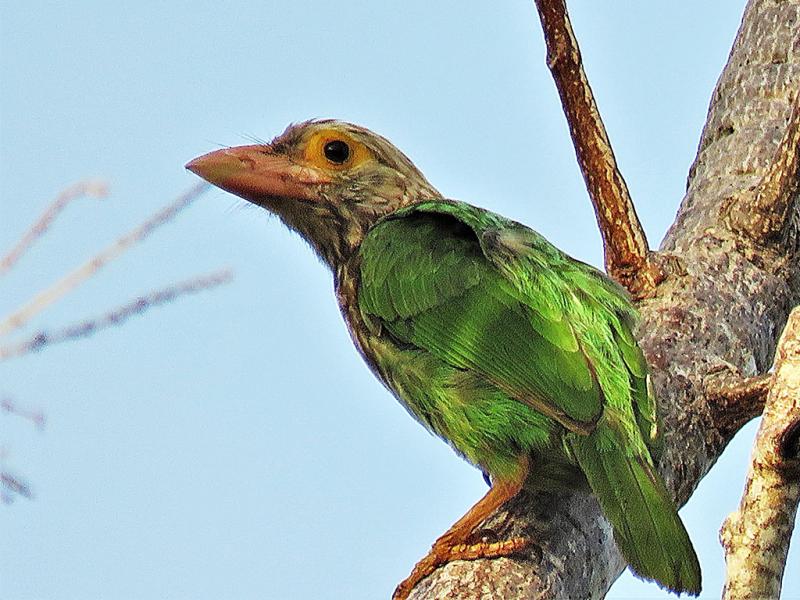
Lineated Barbet
The barbets are the only family other than the woodpeckers that drill into trees with their beaks to create their own nesting holes. They lay between two and five white eggs which the mother incubates for about two weeks. Camouflage for eggs is unnecessary in the dark security of a tree hole. Both parents feed the young. The Barbets have zygodactyl feet, with two foreward facing toes and two facing backwards, similar to the woodpeckers with a similar function of enabling them to grip trees.The lineated barbet is found in the Indian sub-continent and across SE Asia. The bird above was photographed in West Bali National Park, Indonesia.
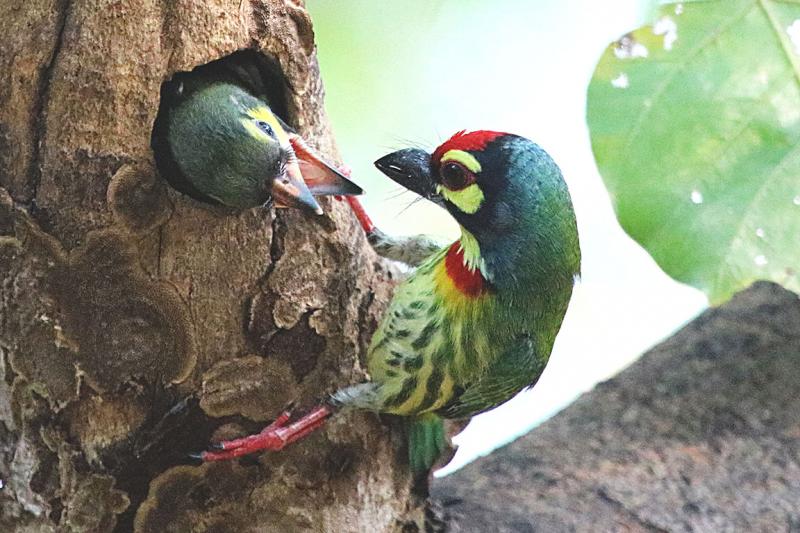
Coppersmith Barbet
The coppersmith barbet is dumpy, short tailed and heavy beaked similar to the lineated barbet and other members of the family. It is also a beautiful bird with bright yellow, red and green plumage. This barbet is a serial monogamists and couples bond for the duration of the mating season often changing partners the following year. It is a difficult bird to see because it is arboreal and often inhabits dense forest and woodland (see Feathers/Camouflage). The coppersmith barbet's call is a repetitive, hammering sound that can be heard for considerable distance even in a forest environment (see Birdwatch/Bird Song). The barbet above was photograpehd in Suan Rot Fai Park, Bangkok. It is most visible during the nesting season when it is feeding chicks. Their nesting holes are often on the underneath of tree branches and they frequently hang upside down outside the hole gripping the bark with their zygodactyl feet. The coppersmith barbet is the most widely distributed Asian barbet and is found across India and South East Asia.
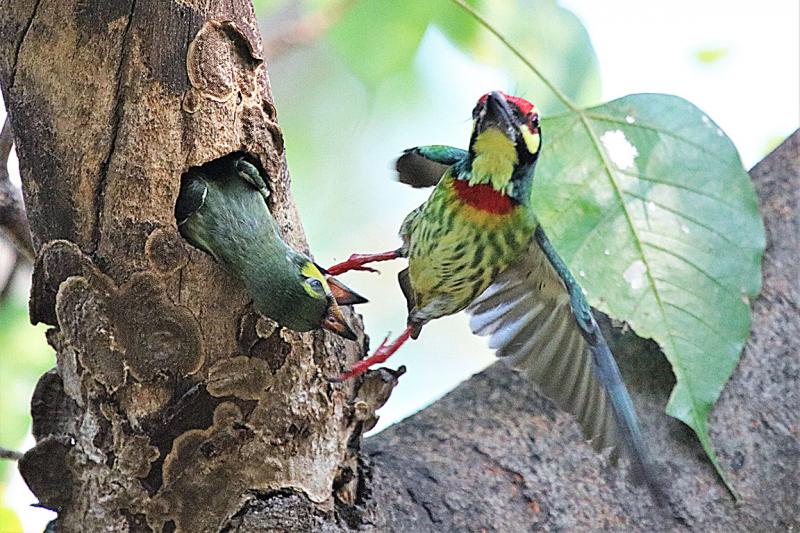
Coppersmith Barbet
As the barbet flies away, you can see the voracious hunger of at least one very demanding chick, fed on a diet of berries, seeds and insects.
Ploceidae - The Weavers
Weavers are so called because of the elaborate and ingenious nests they build from grasses. They are both "gregarious" (sociable) and polygamous and males will mate with several females in the same season. The sociable weaver builds the largest nest of any bird with up to 100 pairs using the same large, honeycombed, haystack like structure often located in an acacia or mopane tree. More than one generation may share in the care of chicks. Females have been known to produce many broods in the same season in response to predation. Colonies may remain active over many generations and nests survive up to a hundred years.
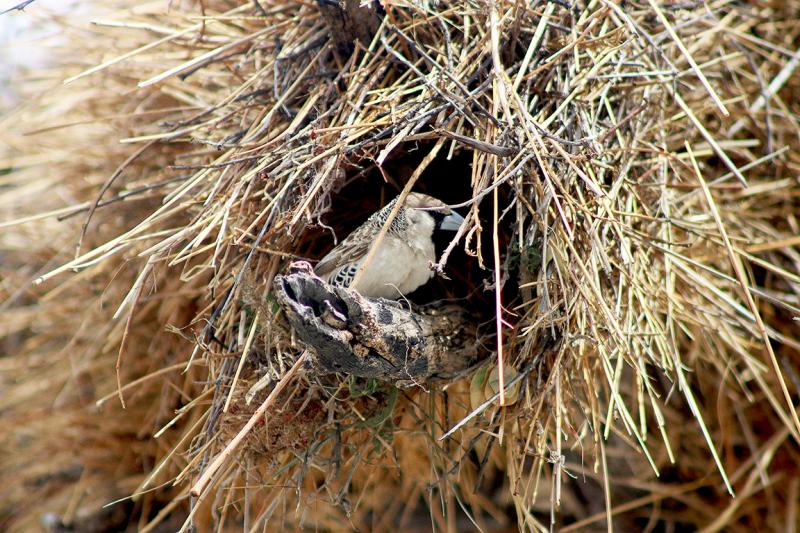
Sociable Weaver
The sociable weaver above was photographed at the entrance to its nest in Etosha National Park, Namibia which has the preferred habitat of savannah grassland that provides nesting material.
Unlike the sociable weaver, the cape weaver prefers to build their nests near water and often choose willow trees where they weave a complex domed structure. I photographed the male cape weaver below collecting grasses for its nest on Thesen Island, Knysna, South Africa.
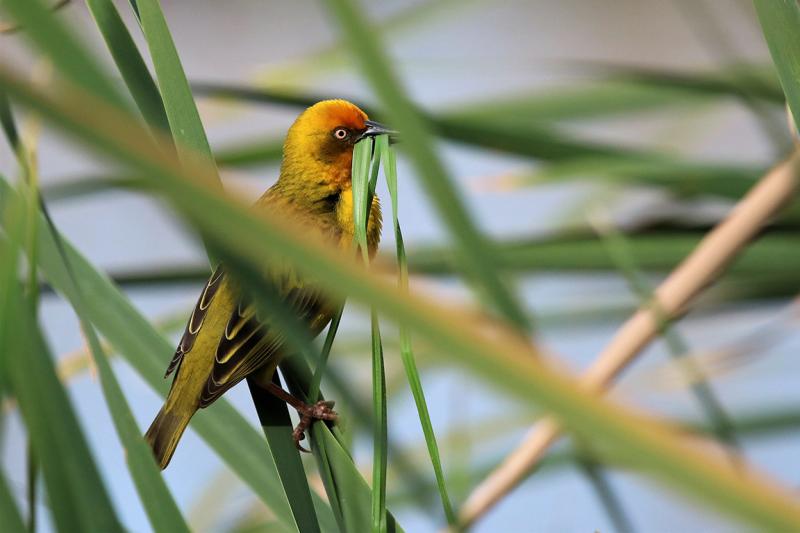
Cape Weaver - Male
Cape weavers frequently nest in colonies which can consist of up to twenty separate nests. In contrast to the columbids' female nest builders, the male cape weaver does all the work taking around seven days to weave the complex domed nest. Once complete, he displays with calls, swaying, and wing flapping, while hanging upside down from the entrance to his nest. If his engineering and acrobatic skills fails to impress potential mates, the disgusted but stoic male will destroy the nest and build another one. If his hard work attracts a female she will enter the nest, take on the task of home decor and line it with soft grass and leaves. The male cape weaver will have up to 7 mates in one season. I was unable to find out if this involved the construction of seven different nests!

Heuglin's Masked Weaver - Male
Note the red eye, in contrast to the cape weaver's yellow eye.
In the photograph above, taken in Arba Minch, Ethiopia, a male Heuglin's masked weaver constructs his nest hanging from the base of the dome where the entrance is located for maximum security.
Females lay 3-5 greenish blue eggs and incubates for around two weeks. Fledglings leave the nest about 17 days after hatching. Like many polygamous species, the female is largely responsible for feeding the chicks,(with occasional help from the male), on a selection of flowers, fruit, grass seeds, nectar and insects. Male Heugel's masked weavers are territorial and guard their territories with song and aggressive posturing.
Empty weavers' nests attract a number of tenants including other species of birds that do not build their own nests, and mice and reptiles often shelter in them.
A Note on Polygamy
Polygamy can be advantageous for many species of bird enabling greater gene variation and increasing chances that some of the offspring will be fitter and cleverer. There may also be a greater number of eggs laid and additional care provided by multiple partners. Polygamy often occurs in adverse conditions such as those of many weavers which nest in arid regions, when several partners will increase chances of offspring surviving.
Pycnonotidae - The Bulbuls
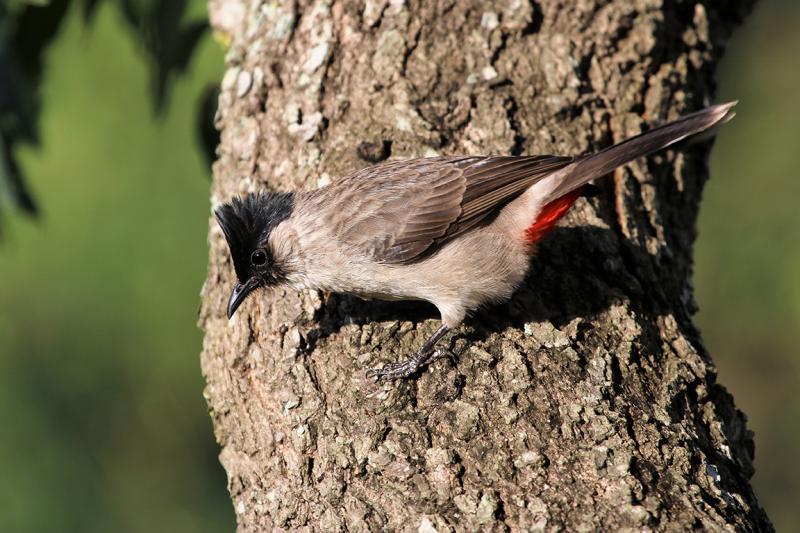
Sooty-headed Bulbul
The sooty-headed bulbul is a common resident across South East Asia. Although frequently a forest dweller, it is also found in more open woodland areas. Notice the red "vent", the plumage around the cloaca. Several of the bulbul family in Asia have a colourful vent which may be orange or yellow as well as red. It has probably evolved as a provocative signal of readiness to mate when flaunted during courtship displays.
The bulbuls are medium sized passerines widely distributed in Africa, the Middle East, the Asian tropics and Japan. There are more than 150 species and 27 genera. Wheras African bulbuls favour rainforest, Asian bulbuls prefer open woodland and the fringes of forests. They are mostly monogamous. Males and females look similar although females may be slightly smaller. Bulbuls are omnivores with a diet of fruit, seeds, nectar, insects and occasionally small vertebrates such as lizards and amphibians. Nests are the typical passerine cup shape made of grasses and twigs and lined with feathers, leaves and other soft materials. Eggs are colourful with a pale pink or mauve background and with purple, red or reddish brown speckles.
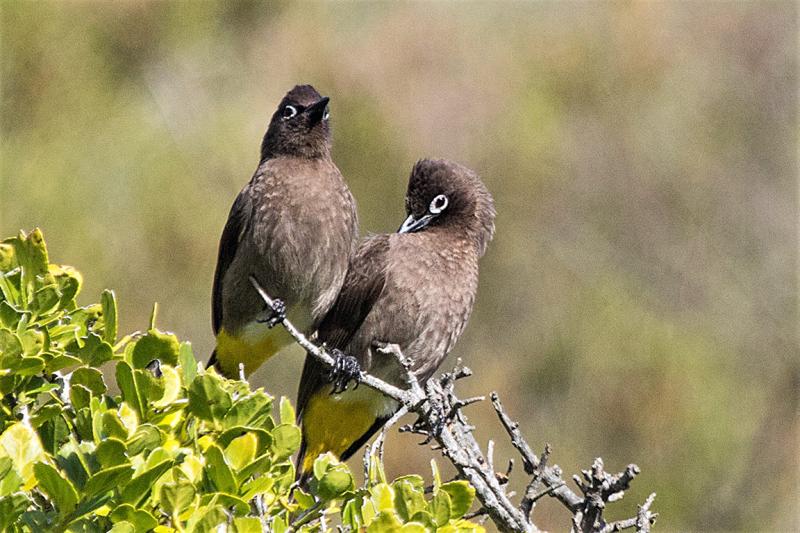
Cape Bulbul
The cape bulbul is "endemic" (native and restricted) to bush, fynbos, open forest, gardens and parks in the Cape region of South Africa. It is a common and conspicuous bird perching prominently and noisily at the top of small trees and bushes. The couple above were photographed at the Robberg Penninsula, Western Cape, South Africa. Notice the yellow vent, contrasting with the red of the sooty-headed bulbul, and the diagnostic white eye ring.
It breeds during the Southern Hemisphere spring and summer. The female builds the nest, a densely packed, messy cup of twigs, grass and rootlets lined with finer plant material and with a foundation of larger twigs. It chooses a location amongst the foliage off a small tree or shrub taking up to 10 days to complete, with the male checking on progress.The female lays two to five eggs and she incubates a alone.
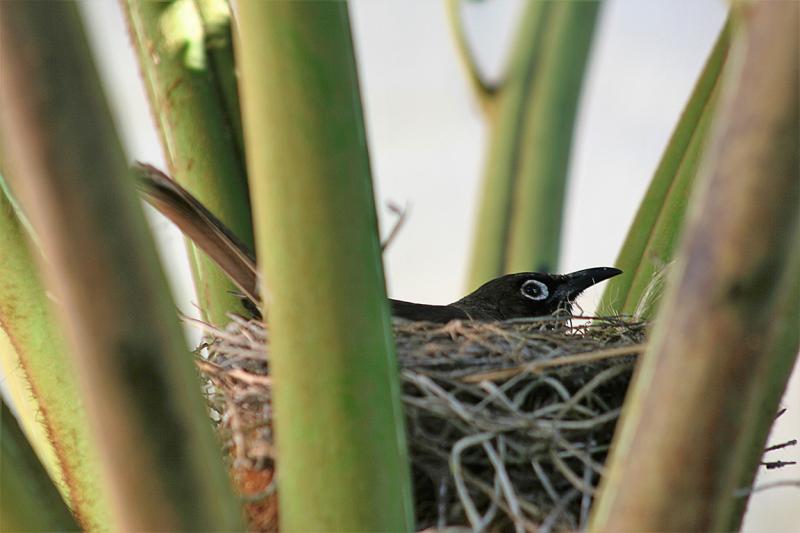
Cape Bulbul - Female
The female above was photographed in a garden on Leisure Isle, Knysna, South Africa.
Females tends to leave the nest frequently to forage and researchers have estimated they spends only 60% of her time at the nest. The chicks are fed on a diet of fruit, nectar and insects with the male, at last, playing an active part. Chicks are altricial and leave the nest before they can fly after about 10 days. It is only when they are 50 days old that they become fully independent.